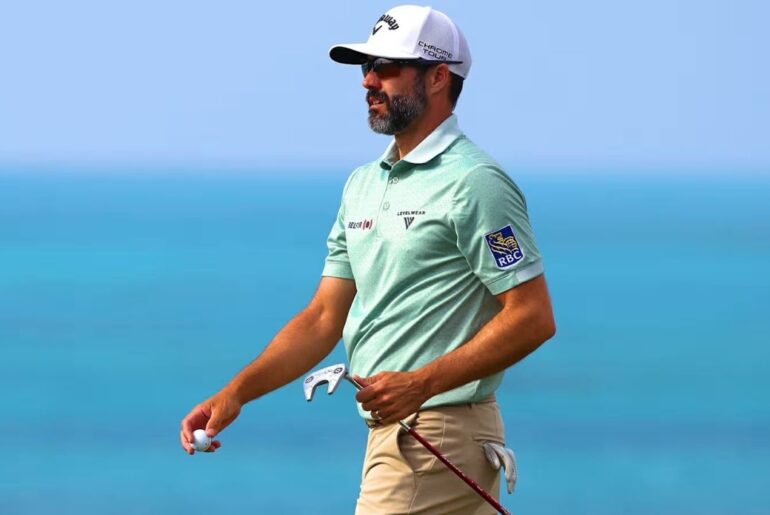#golfer #golfswing #golf #pga #golflife #golfing # #LIVGolf #PGATour #GolfDrama #stewartcink #tomwatson
Tom Watson has been accused of exposing Stewart Cink for ruining his career, but here’s the truth that nobody talks about. Stewart Cink didn’t ruin anything. He earned one of the greatest victories in golf history, and it’s time we finally gave him the credit he deserves.
I had such a such an admiration for Tom even before this, but this week uh the way he’s played has just been it’s blown everybody away, including me. And then um Tom Watson has been accused of exposing Stuart Sink for ruining his career. But here’s the truth that nobody talks about. Stuart Sink didn’t ruin anything. He earned one of the greatest victories in golf history, and it’s time we finally gave him the credit he deserves. Before we dive into what really happened at the 2009 Open Championship, let’s talk about who Steuart Sink actually was. This wasn’t some random guy who got lucky for one week. Sink was already an elite golfer with serious credentials. He had won five PGA Tour events before stepping onto the course at Turnberry. Just one year earlier in July 2008, he reached a careerhigh ranking of fifth in the world. Think about that. Fifth in the entire world. He had proven himself at the biggest stages, too, finishing third at the 2001 US Open and earning top three finishes at both the 1999 PGA Championship and the 2008 Masters. This wasn’t a fluke story. This was a talented golfer who had been building toward a major championship his entire career. His consistency and skill put him in position to win the biggest tournaments. When Sink arrived at Turnberry in 2009, he was ready. He belonged there. But here’s where things get complicated. The 2009 Open Championship wasn’t just another golf tournament. It became something much bigger because of Tom Watson. Watson was 59 years old and trying to do the impossible. He wanted to become the oldest player ever to win a major championship. Just 9 months before the tournament, he’d had hip replacement surgery. Nobody expected him to compete, let alone contend. But Watson defied all logic and all expectations. The tournament was held at Turnberry, which made everything even more emotional. Back in 1977, Watson had won the famous Duel in the Sun at that same course, battling Jack Nicholas in one of golf’s greatest moments. Now, more than 30 years later, he was back trying to create magic again. The world’s media fell in love with the story. Fans everywhere desperately wanted Watson to win. Even Sink had noticed Watson’s incredible form earlier that year during a cold, wet practice round at Augusta. Sink watched Watson hit low straight shots through crosswinds and thought to himself that Watson could really do something at the British Open. And Watson did do something special. But because everyone wanted the fairy tale ending so badly, Sink was automatically cast as the bad guy. He became the antagonist not because he did anything wrong, but simply because he stood in the way of the story everyone wanted. His competence and skill made him the perfect villain. He was the younger, fitter champion who represented cold reality instead of the warm fantasy people craved. If you’re enjoying this deep dive into one of golf’s most misunderstood moments, hit that subscribe button and drop a comment below. Do you think Stuart Sink gets enough credit for his 2009 Open victory? Let me know what you think. Now, let’s talk about what actually happened during that final round. Tom Watson led going into Sunday, three shots ahead of Sink, who started the day in sixth place. Sink played incredible golf. He shot 69 in the final round, which is impressive under any circumstances, but especially under major championship pressure. On the 18th hole, he made a clutch 16 ft birdie putt that brought him to two under par with a total score of 278. At that moment, Sink was barely noticed. Everyone was watching Watson. The entire golf world had their eyes on the 59-year-old legend, hoping he would complete the miracle. Watson came to the 18th hole, needing just a par to win the championship outright. He hit his eight iron second shot exactly as he intended from 187 yds out, but the ball bounced over the green. Watson couldn’t get up and down. He missed an 8-ft putt for par. That miss changed everything. Suddenly, Stuart Sink went from being an afterthought to being the guy standing between Tom Watson and history. The tournament went to a four-hole playoff. But before that playoff started, something controversial happened. There was a 45minute delay between the end of regulation play and the start of the playoff. During those 45 minutes, the entire atmosphere changed. It went from the greatest story ever told to just another golf tournament. Fans felt deflated. Thousands of people started walking to the parking lots. The emotional energy just drained away. Some people accused Sink of using delay tactics, possibly taking an extra long bathroom break to mess with Watson’s concentration. The truth is that any delay was always going to help the younger player. Sink was 36 years old. Watson was 59. That 23-year age gap meant that any extra time to rest and recover would benefit Sink more. But here’s what really matters. Sink used that time professionally. He had actually prepared for this exact moment mentally. He had practiced putting on practice greens countless times, telling himself, “This is to beat Tom Watson in the open.” Now it was happening in real life. He cleared his mind and focused on winning his first major championship. He knew nobody was rooting for him. He embraced being the underdog and said that was okay with him. While Watson dealt with exhaustion and the emotional shock of missing that parut, Sink stayed calm and got ready to compete. And compete he did. The four-hole playoff was not close. It was decisive and completely one-sided. This is where Stuart Sink proved he was a true champion. Over those four holes, the fifth, 6th, 17th, and 18th, Sink played with clinical precision. He finished two under par. He made two pars and two birdies. That is exceptional golf under the most intense pressure imaginable. Tom Watson struggled badly, finishing four over par. Sink won the playoff by six strokes. Six strokes. That’s not a close call. That’s dominance. Let me break down what happened on each hole. On the fifth hole, Sink made par while Watson made bogey. That gave Sink the psychological advantage. On the sixth hole, both players made par. Then came the 17th hole where the playoff was really decided. Sink made birdie. Watson’s drive was tired and weary. He hit two poor recovery shots from the rough and made double bogey. Just like that, Sink had a four-shot lead. They still had to play the 18th hole, but it was basically over. Sink finished with another birdie. Watson made bogey. Final margin, six strokes. This performance destroys the argument that Sink didn’t deserve to win. Before 2009, some critics said Sink lacked clutch ability. They said he won tournaments but never closed dramatically. The playoff proved them completely wrong. Sink performed at the highest level in the most highstakes scenario of his entire career. He didn’t just survive, he dominated. Two underpar in a four-hole playoff is incredible. Doing it against immense pressure and with an entire crowd rooting against you makes it even more impressive. The statistics don’t lie. Stuart Sink earned that Claret jug through pure skill and mental toughness. This was objective proof that he belonged among golf’s champions, but the golf world didn’t see it that way. The reaction to Sink’s victory was harsh and unfair. He was immediately labeled as the man who prevented the greatest sporting story in recent memory. The media had been completely invested in Watson’s narrative. They saw the tournament as a choice between man bites dog, which was Watson winning, or dog bites man, which was Sink winning. The press framed Sink’s victory as realitydefeating fantasy as pros having the final word over poetry. Instead of a celebration, the atmosphere felt like a funeral. During the playoff, fans were literally yelling for Kink’s ball to go into bunkers. They screamed for his putts to miss. By the time the players reached the 17th hole, crowds were leaving the course. They couldn’t bear to watch their fairy tale die. When someone asked Sink if he felt like the villain in a Hollywood movie who stole the hero’s girlfriend, he responded with humor and grace. He said, “Well, as long as I get the girl, I’m okay with that. I’ve been the underdog before, the guy that no one is rooting for, and that’s okay. Maybe that will change now.” Years later, people still told him, “You stole the open from Tom Watson.” But Sink always defended his victory with quiet confidence. He pointed out that Watson’s incredible run drew an audience that wouldn’t normally watch golf. Even though Watson didn’t win, that huge audience learned about Stuart Sink and that was the way it was supposed to be. Most importantly, Sink said, “In my heart, I know I played well enough to win it, and I did win it. I finished it off in great style. Here’s something that proves the villain narrative was completely made up. Stuart Sink and Tom Watson remained friends. Their relationship was never damaged. A year after the playoff, they played practice rounds together at St. Andrews during the next Open Championship. Watson’s disappointment was focused on his own execution. He admitted that his missed par putt on the 72nd hole was his worst shot of the week, and Watson recognized that Sink played well enough to win. This mutual respect between the two competitors shows the truth. The narrative friction was manufactured by the media and emotional fans. There was never any real conflict between Sink and Watson. There was no unsportsmanlike conduct, no gamesmanship that crossed the line, just two professionals competing at the highest level with one playing better when it mattered most. Now, I won’t pretend everything was perfect after Turnberry. The 2009 Open Championship was Stuart Sink’s first and only major championship victory, and what followed was difficult. Sink didn’t win another PGA Tour event for more than 11 years. His next victory didn’t come until September 2020 at the Safeway Open. That 11-year gap is shocking. It’s hard not to wonder if the intense pressure, the media scrutiny, and the public’s negative reaction took a toll on him. After reaching the peak of his career, he struggled to recapture that form. The spoiler narrative may have affected his competitive edge in ways we can’t fully measure. Going 11 years without winning after winning a major championship is a significant statistical marker. It suggests that the emotional weight of Turnberry may have stayed with him. But here’s where Stuart Sink’s true character shines through. He came back in his late 40s. Sink returned to winning form. He won the Safeway Open in 2020 at age 47. Then he won the RBC Heritage again in 2021. This comeback proves his incredible resilience. The passage of time allowed him to move beyond the emotional trauma of 2009. He separated his identity from that controversial narrative and played great golf again. Yes, Stuart Sink will always be remembered as the man who stopped Tom Watson’s historic bid to become the oldest major champion ever. But his victory was earned through merit and skill. The 2009 Open Championship showed his clinical precision, his mental toughness, and his ability to perform under the most intense scrutiny imaginable. His two underpar playoff performance and his six-stroke victory margin are permanent statistical proof of his excellence. His resilience in returning to victory after 11 years demonstrates quiet strength that deserves our respect. Stuart Sink is not a villain. He’s a champion who earned his place in golf history. If this video changed your perspective on Stuart Sink and the 2009 Open, smash that like button and subscribe for more golf stories. Drop a comment and tell me what you think about Sink’s legacy. Should he be celebrated more for what he accomplished? Let’s talk about it.








1 Comment
only 99.9% of people watching were hoping TOM would get it done.